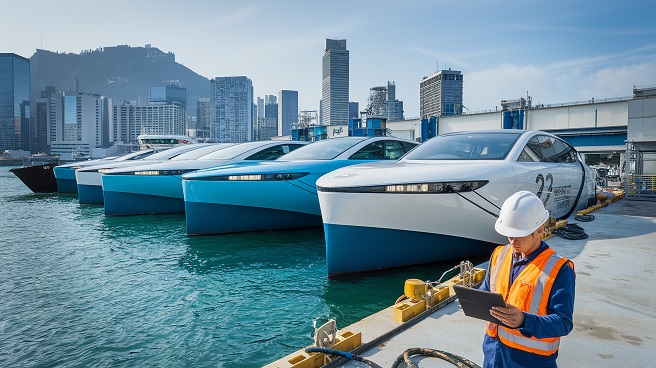The marine vessels market is poised for steady growth, projected to reach USD 133.63 billion by 2030, up from USD 111.10 billion in 2024, at a CAGR of 3.1%. In terms of fleet size, the market is expected to expand from 61,671 units in 2024 to 70,237 units by 2030.
This growth is driven by:
✅ Expanding global trade, increasing demand for commercial ships
✅ Ongoing naval fleet modernization by military forces
✅ Rising tourism and passenger ship demand
✅ Technological advancements in fuel-efficient and sustainable vessels
Download PDF Brochure @
https://www.marketsandmarkets.com/pdfdownloadNew.asp?id=74199246
Key Market Drivers
1. Growth in Global Trade & Maritime Transport
- Over 80% of global trade volume and 70% of trade value is transported by sea.
- The need for bulk carriers, containerships, and tankers continues to rise.
- Increasing globalization and e-commerce fuel demand for efficient logistics and shipping networks.
2. Naval Modernization & Defense Investments
- Military navies worldwide are expanding their fleets for security and strategic dominance.
- Countries such as China, India, the U.S., and Russia are increasing investments in frigates, submarines, and aircraft carriers.
- The frigate segment is projected to witness the fastest growth due to its cost-efficiency and versatile operations.
3. Technological Advancements & Sustainability Initiatives
- The transition to low-carbon fuels such as green methanol and LNG-powered vessels is gaining momentum.
- Adoption of autonomous vessels and AI-driven navigation systems enhances efficiency.
- Companies like Cargill, Amazon, and Walmart are pushing for net-zero carbon emissions in shipping logistics.
Market Challenges
1. High Capital Costs & Financing Barriers
- The rising cost of shipbuilding and compliance with environmental regulations pose challenges.
- New vessel prices, including VLCCs, Suezmax, and Aframax, have surged by 50% since 2020.
2. Aging Fleet Management
- In 2024, the average age of crude and refined product tankers is 13.2 years—the highest in two decades.
- Older vessels face higher maintenance costs and stricter environmental regulations such as IMO’s EEXI and CII standards.
3. Supply Chain Disruptions & Geopolitical Instability
- Russia-Ukraine war and global conflicts have led to freight rate spikes (some routes up by 400% daily).
- Limited shipyard capacities and rising material costs slow down fleet renewal efforts.
Regional Market Insights
🌏 Asia-Pacific – The Largest & Fastest-Growing Market
- Expected to reach USD 68.94 billion by 2030 (CAGR 1.3%).
- China, South Korea, and Japan dominate global shipbuilding and exports.
- China’s shipbuilding orders increased by 50% from 2020 to 2023, holding 58.1% of global market share.
🌍 North America – Strong Military and Cruise Ship Demand
- U.S. Navy investments in amphibious ships and destroyers continue to grow.
- The cruise tourism industry is rebounding post-pandemic, driving demand for luxury vessels.
🌍 Europe – Focus on Green Shipping & Regulations
- EU’s Green Deal encourages LNG and hydrogen-powered ships.
- Shipbuilders like Fincantieri (Italy) and Meyer Werft (Germany) are pioneering low-emission cruise ships.
Key Industry Developments
📌 December 2024 – Samsung Heavy Industries secures a contract for two very large ethane carriers, delivery by 2027.
📌 September 2024 – Huntington Ingalls Industries wins USD 9.6 billion contract for U.S. Navy amphibious ships.
📌 August 2024 – Mitsubishi Heavy Industries to build Japan’s first Aegis System Equipped Vessel (ASEV).
📌 June 2024 – Hanwha Ocean (South Korea) acquires Philly Shipyard (US) for USD 100 million.
Competitive Landscape
Top Marine Vessel Manufacturers
China State Shipbuilding Corporation (CSSC) – China
Fincantieri S.p.A. – Italy
Huntington Ingalls Industries – U.S.
Hyundai Heavy Industries – South Korea
Mitsubishi Heavy Industries – Japan
Naval Group – France
Austal Limited – Australia
Mazagon Dock Shipbuilders Limited – India
Ask for Sample Report @
https://www.marketsandmarkets.com/requestsampleNew.asp?id=74199246
Future Outlook & Opportunities (2024-2030)
🚢 Increased investments in hybrid propulsion and green fuels will drive market growth.
🚢 AI & automation will enhance operational efficiency in commercial shipping and naval fleets.
🚢 Fleet expansion and aging vessel replacements will open new opportunities for shipbuilders and suppliers.
As the marine vessels market continues to evolve, industry players must navigate regulatory challenges, technological innovations, and shifting geopolitical landscapes to remain competitive.
